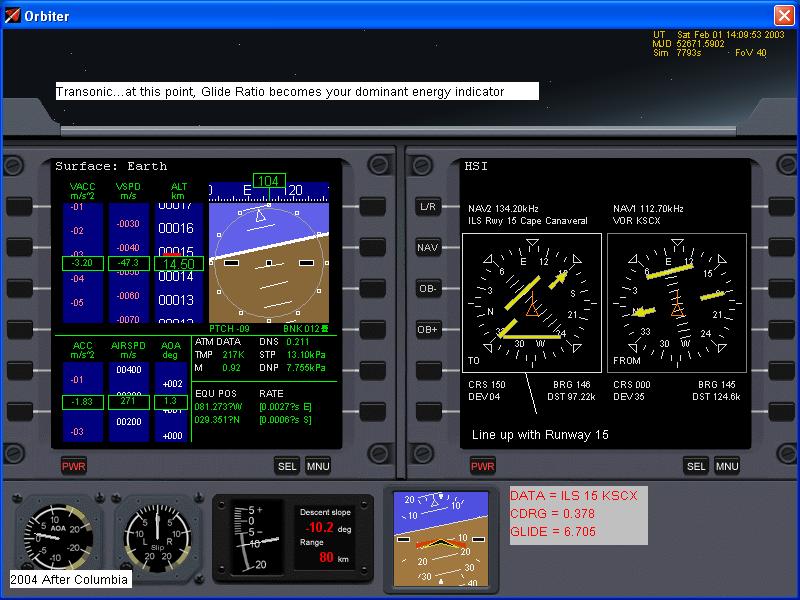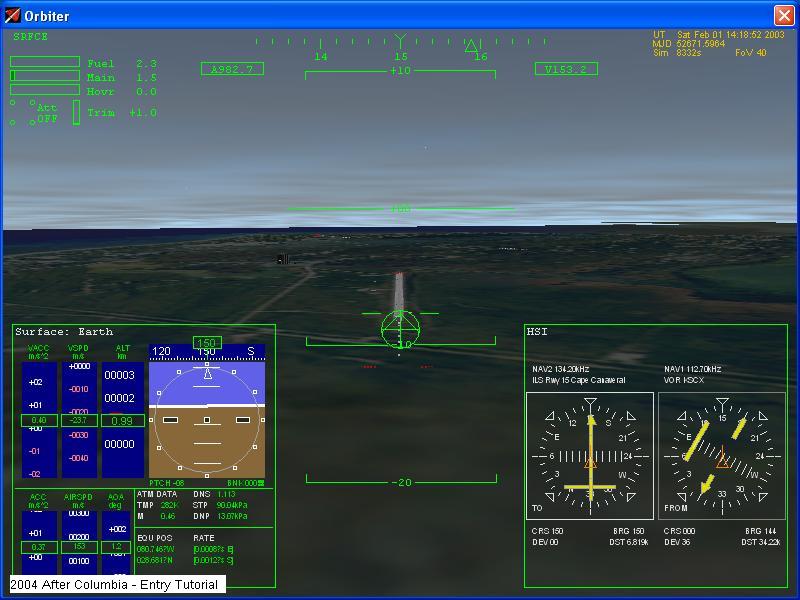The TAEM guidance steers the Orbiter to the nearest of the two Heading Alignment Circles (HAC), whose
radii are approximately 18,000 feet [5,500m] and which are located tangent to, and on either side of, the approach end of
the runway centerline. ... The vehicle slows to subsonic velocity at approximately 49000 feet [15000 m] about 30 miles [48km]
from the runway.

I did not realize until the production of this tutorial that the desirable conditions for going subsonic in the Delta
Glider are so close to those for Shuttle if an unpowered landing is desired. It is best to delay speedbrake application
until the resulting glide slope will place your splat point a couple hundred metres short of the runway. The reason
is simple, Delta Glider's airbrake, unlike Shuttle's has only two positions, open and closed...this is when Delta Glider quits
being the pussycat I described earlier. Full airbrake glide is about 40 degrees at a constant airspeed of about 240-270
m/s (540-600 mph) You want to target airbrake opening to be about 1.5 times your altitude from the runway.

Here, I have added just enough power for a powered glide from the current conditions. For the current distance
from the runway, I should be about 8000-15000m altitude (Shuttle would be about 8-9000m.) If I were over 14000m, it
would be time to deploy the airbrakes and drop like a rock with the nose pointed well short of the runway threshhold.
This approach (which the Shuttle uses) allows the most runway to be used for the landing flare and roll out.
The approach and landing phase begins at 10,000 feet [3050m] at an airspeed of 345 mph [154m/s],
either 6.7 [10780m] or 7.3 miles [11750m] from touch down (for -20 and -18 degrees (This is over seven times as
steep as that normally used by commercial airliners [3deg]), respectively. Autoland guidance is initiated at this point
to guide the Orbiter to the -20 or -18 degree glideslope aimed at a target 7,500 [2280m] feet short of the runway. The
descent rate is greater than 10,000 feet per minute [50.8m/s] (...500 feet per minute [2.54m/s] for commercial air traffic.)
The Delta Glider equivalent with speedbrakes wide open is an even more terrifying 240m/s airspeed divided into a groundspeed
of 184m/s and a descent rate of 154 m/s (30300 feet per minute) at a glideslope of 40deg. The autoland phase for
Shuttle takes 60 seconds. The Delta Glider's dive takes 20 seconds from the same altitude. It is pretty obvious
why I like to have my fuel reserve! I don't think there is a specified maximum gear extension speed for the Delta Glider,
but I'd guess at 180m/s. In modern versions of Orbiter, the landing gear generates a significant parasite drag, causing
her to pitch down. It is best to wait until the last possible moment to release the landing gear (Shuttle does this
too.) To attain the least drastic trim change for the flare, command the gear release just after commanding airbrakes
closed (Ctrl-B for airbrakes, G for landing gear, in the same second if possible.)

|
| The experienced IFR pilot might ask about the ILS glideslope...yes it is broken! |
The speedbrake is used to control velocity, and at 2,000 feet [610m] altitude, a pre-flare maneuver
is started to position the vehicle for a 1.5-degree glideslope in preparation for landing.
Delta Sprint equivalent procedure. At 1000m, close the speedbrake and immediately deploy the landing gear (Ctrl-B,
G) apply elevon control to aim the Delta Glider nose at pitch down 3 degrees. With trim angle of attack, this will result
in the Delta Glider settling to 1.7 degrees glideslope. If the dive was well targeted, the nose should be pointed at the
threshhold. Speed should drop and the Delta Glider may want to climb at first. Airspeed will be dropping from
about 200m/s to 150m/s as the Delta Glider passes over the runway threshold at about 100m altitude. This should all
take about 20 seconds.
The final phase reduces the sink rate to less than 9 fps [2.7m/s], and the crew deploys the landing
gear at 300ft [90m] altitude. A final flare maneuver lowers the sink rate to 3 fps [0.9m/s] and touchdown occurs approximately
2,500 feet [760m] past the runway threshold at a speed of roughly 225 mph [-235mph; 101-105 m/s]

Once past the runway threshold, go down to about 20m, then flare, holding the nose up until the speed drops to about
130m/s, then gently lower her to the runway. Once both main and nose gear are down, deploy the airbrakes using Ctrl-B.
If wheel braking is needed, use Ctrl-down arrow (not the numpad arrow, but the actual arrow keys.) This will bring up
the panel controls for the wheel brakes. Using '.', and ',' is possible, but not exactly realistic, as the Delta Glider
will stop about as fast as if it hit a brick wall.
|

